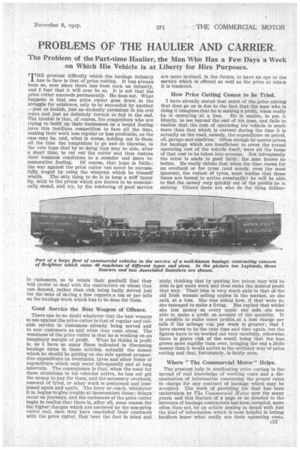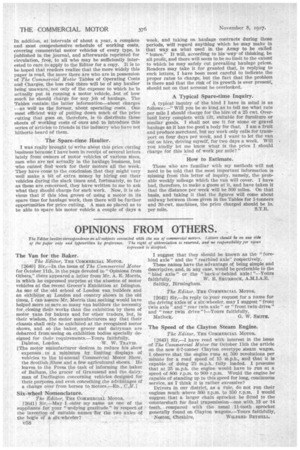PROBLEMS OF THE HAULIER AND CARRIER.
Page 115

Page 116

If you've noticed an error in this article please click here to report it so we can fix it.
The Problem of the Part-time Haulier, the Man Who Has a Few Days a Week on Which His Vehicle is at Liberty for Hire Purposes.
THE greatest difficulty which the haulage industry has to face is that of price cutting. It has always been so, ever since there has been such an industry, and I fear that it will ever be so. It is not that the price cutter succeeds permanently. He does not. What happens is that one price cutter goes down in the struggle for existence, only to be succeeded by another —just as foolish, just as wickedly persistent in his evil Nays and just as definitely certain to fail in the end. The trouble is that, of course, his competitors who are trying to build up their businesses on a sound footing have this insidious competition to face all the time, making their work less regular or less profitable, as the case may be, and, what is worse, holding out to them all the time the temptation to go and do likewise, in the vain hope that by so doing they may be able, after a short time, to cut out the cutter and thus restore their business conditions to a sounder and more remunerative footing. Of course, that hope is futile ; the war against the price cutter can never be successfully, waged by using the weapons which he himself wields. The only thing to do is to keep a stiff upper lip, stick to the prices which are known to be economically_ sound, and try, by the rendering of good service
to customers, so to retain' their goodwill that they will prefer to deal with the contractors on whom they can depend, rather than risk being badly served just for the sake of saving a few coppers a ton or per mile on the haulage work which has to be done for them.
Good Service the Best Weapon of Offence.
,There can be no doubt whatever that the best weapon to use against the price cutter is that of regular and reliable service to customers already being served and to new customers as and when they come along. The weakness of the price cutter is that he is working on an imaginary margin of profit. What he thinks Is profit Is, as I have so many times indicated in discussing haulage rates in these articles, actually the money which he should be putting on one side against prospective expenditure on overhauls, tyres and other items of expenditure which only recur infrequently and at long intervals. The consequence is that, when the need for these attentions to his vehicles arrive, he has not got the money to pay for them, and the necessary overhaul, renewal of tyres, or other work is postponed and postponed again and again. The lorry or coach, whichever it is, begins to give trouble at inconvenient times ; delays occur on journeys, and the customers of the price cutter begin to realize that there is, after all, some reason for the higher charges which are tendered by the non-price cutter and, once they have concluded their contracts with the price cutter, they bear the fact in mind and
are more inclined, in the future, to have an eye to the service which is offered as well as the price at which it is tendered.
How Price Cutting Comes to be Tried.
I have already stated that much of the price cutting that does go on is due to the fact that the man who is doing it imagines that he is making a profit, when really he is operating at a loss. He is unable, to put it bluntly, to see beyond the end of his nose, and fails to realize that the cost of operating his vehicle is much more than that which is current during the time it is actually on the road, namely, the expenditure on petrol, oil, garage and sundries. Often enough he quotes prices for haulage which are insufficient to cover the actual operating cost of the vehicle itself, were all the items of that cost to be taken into account. Not infrequently the error is made in good faith; the man knows no better. He really thinks that when the time comes for an overhaul or for tyres (and surely, even the most ignorant, the veriest of tyros, must realize that those times are bound to arrive eventually) he will be able to find the money very quickly out of the profits he is making. Others there are who do the thing deliber
ately, thinking that by quoting low prices they will be able to get more work and thus make the desired profit that way. Their idea is very much akin to that of the old Irish woman selling apples in the market, as she said, at a loss. She was asked how, if that were so, she managed to make a living. She replied that whilst she lost money on every apple she sold, she was able to make a profit on account of the quantity. It is posSible to make more profits at a less charge per mile if the mileage run per week is greater ; that I have shown to be the case time and time again, but the figures have to be Worked out very carefully, otherwise there is grave risk of the result being that the loss grows more rapidly than ever, bringing the end a little sooner than it would arrive in the ordinary way of price cutting and that, fortunately, is fairly soon.
Where "The Commercial Motor" Helps.
The greatest help in eradicating price cutting is the spread of real knowledge of working costs and a dissemination of information concerning the proper rates to charge for any contract of haulage which may be accepted. The work of providing for that has been undertaken by The Commercial Motor now for many years, and this feature of a page or so devoted to the interests of haulage contractors has been occupied, more often than not, by an article dealing in detail with just the kind of information which is most helpful in letting hauliers know what really are their operating costs. In addition, at intervals of about a year, a complete and most comprehensive schedule of working costs, covering commercial motor vehicles of every type, is Published in the journal, and afterwards reprinted for circulation, free, to all who may be sufficiently interested to care toapply to the Editor for a copy. It is to be hoped that readers realize that the more widely this paper is read, the more there are who are in possession of The Commercial Motor Tables of Operating Costs and Charges, the less risk there will be of any haulier being unaware, not only of the expense to which he Is actually put in running a motor vehicle, but of how much he should charge for any job of haulage. The Tables contain the latter information—about charges
well as the former, about operating costs. One most efficient way of putting down much of the price cutting that goes on, therefore, is to distribute these sheets of working costs of ours andto introduce this series of articles to friends in the industry who have not hitherto heard of them.
The Spare-time Haulier.
I was really brought to write about this price cutting business becauSe I have been in receipt of several letters lately from owners of motor vehicles of various sizes. men who are not actually in the haulage business, but who cannot find work for their motors all the week. They have come to the conclusion that they might very well make a bit of extra money by hiring out their vehicles during the slack times and, fortunately, so far as these are concerned, they have written to me to ask what they should charge for such work. Now, it is obvious that if this idea grows of using a motor in its spare time for liaulage work, then there will be further opportunities for price cutting. A man so placed as to be able to spare his motor vehicle a couple of days a week, and taking on haulage contracts during those periods, will regard anything which he may make in that way as what used in the Army to be called " bunce." It will, according to his way of thinking, be all profit, and there will seem to be no limit to the extent to which he may safely cut prevailing haulage prices. Readers may take it for granted that, in replying to such letters, I have been most careful to indicate the proper rates to charge, but the fact that the problem is there and that the risk of its growth is ever present, should not on that account be overlooked.
A Typical Spare-time Inquiry.
A typical inquiry of the kind I have in mind is as follows :—" Will you be so kind as to tell me what rate per mile I should charge for the hire of a 25 cwt. Overland lorry complete with tilt, suitable for furniture or similar goods. I shall not use it for stone or gravel haulage as it has too good a body for that. I am a fruit and produce merchant, but my work only calls for transport on four days per week, and I want to let the van out on hire, driving myself, for two days a week. Will you kindly let me know what is the price I should charge for this kind of work per mile?"
How to Estimate.
Those who are familiar with my methods will not need to be told that the most important information is missing from' this letter of inquiry, namely, the probable weekly mileage which the van will cover. I have had, therefore, to make a guess at it, and have taken it that the distance per week will be 300 miles. On that basis, and taking it that the figures will come about midway between those given in the Tables for 1-tonners and 30-cwt. machines, the price charged should be is.
per mile. S.T.R.




















































































































































































